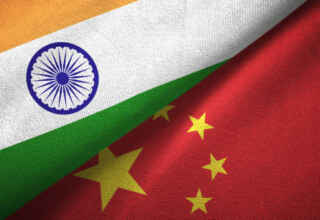
As Western politicians talk about replacing present-day forms of energy production with renewable sources, Russia and China are hedging their bets on nuclear power, as well as a number of EU member states which invest heavily in new nuclear power plants. With the political urge of revolutionizing the world’s energy production, a need for reliable power sources is connected. Still, electricity won from renewable resources is subject to irregular production times and widely varying amounts.
Limits to renewables: intermittency of supply, hence, need for storage technology, unlikely to be covered by batteries; significant land-use impact as renewables are energy-sparse and ask for large-scale construction (Tokimatsu et al., 2003). Nuclear power has been traditionally been based on nuclear fission, the process of splitting atoms in a controlled environment and thereby releasing energy to power electricity generators. This process produces high-level nuclear waste which stays radioactive for generations (only a small fraction remains radioactive for more than 100,000 years) and can lead rarely to accidents (Bradshaw et al., 2011). However, there is another way of harnessing the energy in atoms by the reverse way of fission: nuclear fusion (for more, see below).
This raises the question whether nuclear technology could make a valuable contribution to the much-coveted energy security. Classic nuclear power generation is seen as dangerous and ecologically harmful, although the statistics paint a different picture (Ritchie, 2020). Apart from the Chernobyl and Fukushima incidents no major accident has happened worldwide, whereas wind plants cause a constant stream of casualties through dislodged blades and unsafe working conditions (Caithness Wind Farms, 2021). As an alternative to the traditional nuclear fission reactors, there has been much research and experimenting on nuclear fusion, which is the reverse process of fusing atoms to create energy.
China has made a giant step toward viable fusion power at the end of May at its Experimental Advanced Superconducting Tokamak at the Hefei Institutes of Physical Science of the Chinese Academy of Sciences (Kunyi & Weiduo, 2021). Although the technology is still in its experimental stage, it is considered critical for China’s energy security (Ibid.). Despite a larger turn to renewable resource, nuclear energy celebrates a revival as well, as many EU states are investing in the construction of new nuclear power plants, often with the help of Russia and China which use nuclear power as a geopolitical tool.
On nuclear fusion
Nuclear fusion per se is a simple chemical process, however, to start the reaction, hydrogen isotopes – usually deuterium and tritium – have to be heated to temperatures of 50 million °C to generate plasma which has to be kept under pressure in a strong magnetic field (something a tokamak reactor simulates), in this environment the fusion of nuclei takes place which releases large amounts of energy. The starting point of energy harvesting is reached when a sufficient number of fusion reactions occur to make the process self-sustaining, and can then be maintained by adding continuously new hydrogen. The net energy yield at this point is four times larger than with nuclear fission (World Nuclear Association, 2021).
In the recent Chinese trial a plasma temperature of 120 million °C was sustained for 101 seconds and 160 million °C for 20 seconds (Kunyi & Weiduo, 2021). It should be clear how momentous this achievement has been for fusion power.
As any future energy mix cannot rely completely on renewables there is a need for a constant energy source which can be fusion, especially for countries with the wealth to fund this kind of energy (McGrath, 2019). The energy return on invested of fusion power, a measurement to judge how economical an energy source is, is highest for any available energy source (Nicholas et al., 2021). Other clear advantages are: a low resource constraint as tritium can be won from water and lithium is theoretically available in huge amounts in sea waters; no high-level nuclear waste emitted, and only small amounts of low-level and intermediate-level waste; because of a minimum size of reactors (1-GW class) potential to create huge amounts of energy (Tokimatsu et al., 2003; Pearson et al., 2018).
Even though fusion is dependent on some rare elements, like beryllium (as a neutron multiplier), renewables as well as gas energy technology depend on rare elements: such as indium, gallium and silver for photovoltaics (Tao et al., 2011); neodymium for wind, and nickel and molybdenum for carbon capture and storage (Bradshaw et al., 2011; Kleijn et al., 2011).
Nevertheless, research on fusion energy can also be expected to engender beneficial spillover effects into other scientific areas, for example, in medicine to enhance non-invasive imaging to cancer therapy, or in waste treatment to transform hazardous waste into vitrified and safe-to-dispose products (Wendt et al., 2015). Also, the spread of fusion technology in favor of traditional nuclear fission may contribute to non-proliferation of nuclear weaponry. Although tritium is a component in thermonuclear weapons, it is of no harm since it requires fissionable material to start any chain reactions (Nicholas et al., 2021).
Geopolitical rivalry may change everything
The leading states in fusion research experimenting with different types of fusion reactors are the UK, Germany, France, the US, Japan, South Korea and China (World Nuclear Association, 2021). Today, the ITER project is the largest worldwide and includes the participation of China, the EU and Switzerland, India, Japan, South Korea, Russia and the US (ibid.). That such a cooperation still exists appears rather improbable seen under the light of the latest developments in the global arena. ITER’s flagship enterprise is the experimental reactor currently being built in the south of France, near Avignon. The EU has stepped up its game with the joint program on fusion, named EUROfusion, started in 2014 providing funding mainly to the ITER project but also approaching issues with the DEMO demonstration reactor, using next generation fusion technology (Oettinger, 2014).
A rough roadmap of fusion research presumes that in the 2040s successor machines to ITER, called the DEMO phase, should be available (Draper, 2018). Germany, Japan and China are researching on new models in state-financed projects (in the former two also with the help of EU subsidies). Commercial use may be feasible from the 2050s onwards, however, this schedule may be overtaken faster by the private sector. More and more private companies are entering the scene with smaller and leaner approaches utilizing the latest innovations from electronics, materials sciences, plasma physics and high-performance computing. The frontrunners are without exception based in North America. Two of them, the US company TAE and the Canadian General Fusion, also receive funding from abroad; the former is working together with the Russian Rusnano, the latter has financial backing from Malaysia’s sovereign wealth fund (Draper, 2018).
Since nuclear fission (and most likely fusion) power plants have a long life cycle, spanning 60 to 80 years, the rising influence of nuclear energy on geopolitical relationships cannot be ignored. With the need of close collaboration to maintain such plants, partnering countries are locked into long and tight relations, a tactic seen favorably by Beijing (Xie, 2021). As such, China’s push into nuclear and renewable energy is more related to geopolitics and its own energy security. In the Chinese Communist Party’s mouthpiece, the People’s Daily, fusion has been clearly named the ” way to solve China’s strategic energy needs” (Zaremba, 2020).
The rift between the US and China, becoming clearer and clearer, raises the possibility of disruption of large international projects, in particular ITER (Carayannis et al., 2020a). One example could be the US-China trade war, when former US President Donald Trump revoked a cooperation of an American company with a Chinese state-owned company to construct an experimental nuclear reactor in China agreed to under his predecessor (Xie, 2021). Further restrictions have been implemented on civilian nuclear technology transfers to China from the US in 2018 (Xie, 2021). During the last administration’s term, the US state department pointed out that China uses its nuclear industry to increase its national power through the development for civilian use and to support its military buildup (ibid.). There is also a growing reluctance of Western companies to cooperate with China as numerous incidences of Chinese espionage have made the former distrustful of Beijing stealing their technologies (Draper, 2018). A breakdown of scientific cooperation and a worsening political climate may lead to the collapse of fusion-related intellectual property rights, a nightmare for private companies heavily invested in the technology (ibid.). What needs to be taken into account, furthermore, is the potential to disrupt fossil-fuel-based economies form the ‘Global South’ and upending intra-regional energy agreements there (Draper, 2018).
In sum, the significance of fusion power for geopolitics has been underestimated by the West because fossil fuels have been cheaper; a growing public distrust of nuclear energy after the Fukushima disaster in 2010 – has has moved renewables to the center hailed as the white knight of future energy supply(Xie, 2021). China, and to a lesser degree Russia, play the nuclear energy game for the long-term seeking for openings in Africa, Asia, South America, the Middle East and even Europe.
Policy recommendations
To prevent a geopolitical polarization of fusion energy, Carayannis and colleagues (2020b) suggested the creation of a global alliance between ‘Global North’ and ‘Global South’ to share the benefits equably around the globe. This initiative should then be under Unesco’s aegis, under whose remit falls the peaceful sharing of scientific developments through education, to give guidance in the race for fusion energy. The targeted supplementation of fossil fuel-based economies in the ‘Global Soouth’ requires a more serious and realistic approach to sustain growth there.
International cooperation may fail when geoeconomic or geopolitical rivalries exacerbate, as first fissures have already appeared. Being still in its experimental stage, lingering problems involve the funding and mitigating of financial risks, the sharing of expertise and technical innovations, and the competition to commercialize as fast as possible to reap hefty profits. Considering the byproducts of research on fusion technology, it is an investment worth to be supported on a large scale.
At the center of the EU, there is an ideological rift between France, which relies heavily on nuclear power, and Germany, which suddenly decided – after the Fukushima incident – to phase out its nuclear power stations only to see the unintended rise in coal-powered plants. Consequently, carbon emissions have spiked contributing to the failure of the Merkel-led government to actually reduce these emissions. We know that energy demand in the time to come will grow and, thus, we need sources to cover it. Instead of an ‘either-or’ between nuclear power – nuclear fusion in particular – and renewables, there should be rather an ‘as well as’. Such a division may hamper the progress in nuclear fusion, also taking into account that both countries are at the forefront. Giving in to pressures from public opinion to only bet on renewables, may give Russia and China leeway to take over to the detriment of Western societies.
In the case of a geopolitical schism in the field of fusion energy research and development, a deepened collaboration between the EU and the US would present an opportunity to improve the transatlantic alliance and, assuming a Chinese breakaway from ITER, build a resilient coalition to contain the latter’s energy ambitions.
As energy security is of utmost importance for the EU’s economic and social future, European policies should incentivize private investors and companies to intensify research and development on fusion power. The EU needs to be less ideological about energy sources and think strategically in the long-term and recognize nuclear power for its undeniable contribution to European energy security and to tailgate the energy transition. Fusion energy has furthered international cooperation so far, and it could still do so.
In short, a number of issues can still derail fusion energy from benefitting Europe and the world or disrupt international relations if successfully implemented. Leaving them unaddressed will be costly in either case.
Bibliography:
Bradshaw, A.M. et al. (2011). Is nuclear fusion a sustainable energy form? Fusion Engineering and. Design, 86 (9–11), 2770-2773.
Caithness Wind Farms (2021). Wind Turbine Accident and Incident Compilation (globally). http://www.caithnesswindfarms.co.uk/fullaccidents.pdf
Carayannis, E.G. et al. (2020a). Nuclear Fusion Diffusion: Theory, Policy, Practice, and Politics Perspectives. IEEE Transactions on Engineering Management (forthcoming).
Carayannis, E.G. et al. (2020b). Towards Fusion Energy in the Industry 5.0 and Society 5.0 Context: Call for a Global Commission for Urgent Action on Fusion Energy. Journal of the Knowledge Economy.
Draper, J. et al. (2018, Jan 11). Geopolitics of fusion at risk in reactor saga. https://www.bangkokpost.com/opinion/opinion/1393862/geopolitics-of-fusion-at-risk-in-reactor-saga
Kleijn, R. et al. (2011). Metal requirements of low-carbon power generation. Energy, 36(9) , 5640-5648.
Kunyi, Y. & Weiduo, S. (2021, May 28). China maintains ‘artificial sun’ at 120 million Celsius for over 100 seconds, setting new world record. https://www.globaltimes.cn/page/202105/1224755.shtml
McGrath, M. (2019, Nov 06). Nuclear fusion is ‘a question of when, not if’. https://www.bbc.com/news/science-environment-50267017
Nicholas et al., 2021). Re-examining the role of nuclear fusion in a renewables-based energy mix. Energy Policy, 149.
Oettinger, G. (2014, Oct 10). Europe launches EUROfusion to make fusion energy a reality. http://horizon2020projects.com/sc-energy/europe-launches-eurofusion-to-make-fusion-energy-a-reality/
Pearson, R.J. et al. (2018). Tritium supply and use: a key issue for the development of nuclear fusion energy.Fusion Engineering and Design, 136, Part B, 1140-1148.
Ritchie, H. (2020, Feb 10). What are the safest and cleanest sources of energy? https://ourworldindata.org/safest-sources-of-energy
Tao, C.S. et al.(2011). Natural resource limitations to terawatt-scale solar cells. Solar Energy Mater. Sol. Cell., 95 (12), 3176-3180.
Tokimatsu et al. (2003). Role of nuclear fusion in future energy systems and the environment under future uncertainties. Energy policy, 31(8), 775-797.
Wendt, A. et al. (2015). Scientific Discoveries and New Technologies Beyond Fusion. Fusion Energy Sciences Advisory Committee – US Department of Energy Office of Science.
World Nuclear Association (2021). Nuclear Fusion Power. https://www.world-nuclear.org/information-library/current-and-future-generation/nuclear-fusion-power.aspx
Xie, J. (2021, Jan 14). China on Track to Supplant US as Top Nuclear Energy Purveyor. https://www.voanews.com/east-asia-pacific/voa-news-china/china-track-supplant-us-top-nuclear-energy-purveyor
Zaremba, H. (2020, Dec 07). Will China Win The Nuclear Fusion Race? https://oilprice.com/Alternative-Energy/Nuclear-Power/Will-China-Win-The-Nuclear-Fusion-Race.html
By Mahmoud Refaat: The European Institute for International Law and International Relations.













